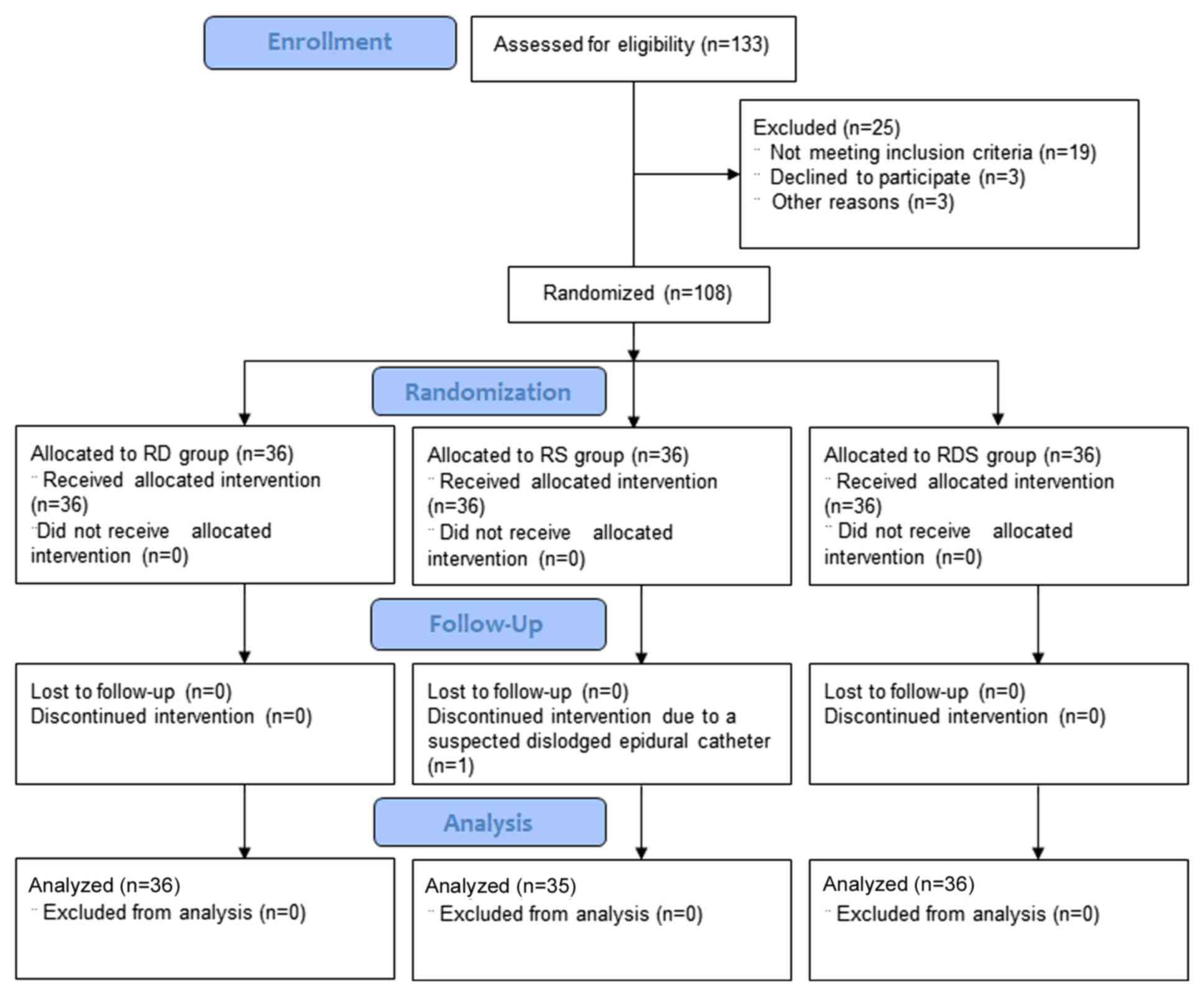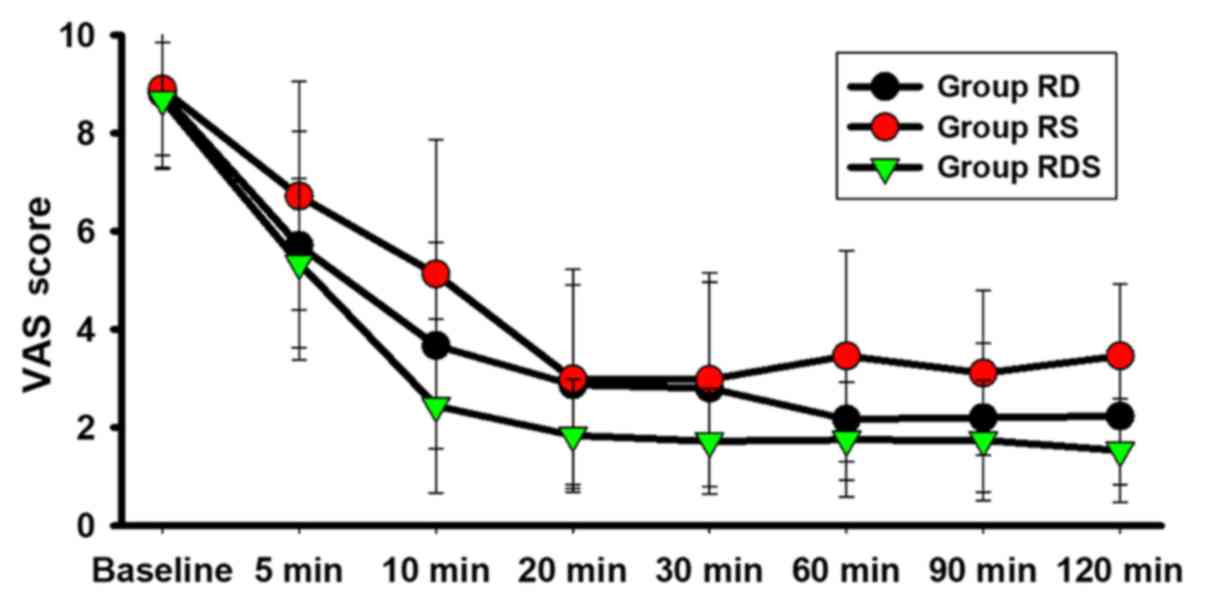|
1
|
Veenhof AA, Vlug MS, van der Pas MH,
Sietses C, van der Peet DL, de Lange-de Klerk ES, Bonjer HJ,
Bemelman WA and Cuesta MA: Surgical stress response and
postoperative immune function after laparoscopy or open surgery
with fast track or standard perioperative care: A randomized trial.
Ann Surg. 255:216–221. 2012.PubMed/NCBI View Article : Google Scholar
|
|
2
|
Keskin HL, Keskin EA, Avsar AF, Tabuk M
and Caglar GS: Pethidine versus tramadol for pain relief during
labor. Int J Gynaecol Obstet. 82:11–16. 2003.PubMed/NCBI View Article : Google Scholar
|
|
3
|
Elbohoty AE, Abd-Elrazek H, Abd-El-Gawad
M, Salama F, El-Shorbagy M and Abd-El-Maeboud KH: Intravenous
infusion of paracetamol versus intravenous pethidine as an
intrapartum analgesic in the first stage of labor. Int J Gynaecol
Obstet. 118:7–10. 2012.PubMed/NCBI View Article : Google Scholar
|
|
4
|
Lebovits AH, Zenetos P, O'Neill DK, Cox D,
Dubois MY, Jansen LA and Turndorf H: Satisfaction with epidural and
intravenous patient-controlled analgesia. Pain Med. 2:280–286.
2001.PubMed/NCBI View Article : Google Scholar
|
|
5
|
Okholm C, Goetze JP, Svendsen LB and
Achiam MP: Inflammatory response in laparoscopic vs. open surgery
for gastric cancer. Scand J Gastroenterol. 49:1027–1034.
2014.PubMed/NCBI View Article : Google Scholar
|
|
6
|
Bajwa SJ, Arora V, Kaur J, Singh A and
Parmar SS: Comparative evaluation of dexmedetomidine and fentanyl
for epidural analgesia in lower limb orthopedic surgeries. Saudi J
Anaesth. 5:365–370. 2011.PubMed/NCBI View Article : Google Scholar
|
|
7
|
Selim MF, Elnabtity AM and Hasan AM:
Comparative evaluation of epidural bupivacaine-dexmedetomidine and
bupivacaine-fentanyl on Doppler velocimetry of uterine and
umbilical arteries during labor. J Prenat Med. 6:47–54.
2012.PubMed/NCBI
|
|
8
|
Debon R, Allaouchiche B, Duflo F, Boselli
E and Chassard D: The analgesic effect of sufentanil combined with
ropivacaine 0.2% for labor analgesia: A comparison of three
sufentanil doses. Anesth Analg. 92:180–183. 2001.PubMed/NCBI View Article : Google Scholar
|
|
9
|
Salgado PF, Sabbag AT, Silva PC, Brienze
SL, Dalto HP, Módolo NS, Braz JR and Nascimento P Jr: Synergistic
effect between dexmedetomidine and 0.75% ropivacaine in epidural
anesthesia. Rev Assoc Med Bras (1992). 54:110–115. 2008.(In
Portuguese). PubMed/NCBI View Article : Google Scholar
|
|
10
|
Al-Mustafa MM, Abu-Halaweh SA, Aloweidi
AS, Murshidi MM, Ammari BA, Awwad ZM, Al-Edwan GM and Ramsay MA:
Effect of dexmedetomidine added to spinal bupivacaine for
urological procedures. Saudi Med J. 30:365–370. 2009.PubMed/NCBI
|
|
11
|
Zhao Y, Xin Y and Liu Y, Yi X and Liu Y:
Effect of epidural dexmedetomidine combined with ropivacaine in
labor analgesia: A randomized double-blinded controlled study. Clin
J Pain. 33:319–324. 2017.PubMed/NCBI View Article : Google Scholar
|
|
12
|
Zhang T, Yu Y, Zhang W and Zhu J:
Comparison of dexmedetomidine and sufentanil as adjuvants to local
anesthetic for epidural labor analgesia: A randomized controlled
trial. Drug Des Devel Ther. 13:1171–1175. 2019.PubMed/NCBI View Article : Google Scholar
|
|
13
|
Qi X, Li Y, Rahe-Meyer N, Huang X, Gu Y,
Wang X, Li Y and Wen Y: Intrathecal dexmedetomidine as adjuvant to
ropivacaine in hysteroscopic surgery: A prospective, randomized
control study. Int J Clin Pharmacol Ther. 54:185–192.
2016.PubMed/NCBI View
Article : Google Scholar
|
|
14
|
Qi X, Chen D, Li G, Huang X and Li Y, Wang
X and Li Y: Comparison of intrathecal dexmedetomidine with morphine
as adjuvants in cesarean sections. Biol Pharm Bull. 39:1455–1460.
2016.PubMed/NCBI View Article : Google Scholar
|
|
15
|
Chen C, Hei Z, Xing J, Zhu Q, Qiu R, Liu
J, Gong C, Cheng N, Zhou S and Shen N: Laryngoscopic techniques
modulate anaesthesiologists' perception of halitosis in patients: A
randomised controlled trial. Eur J Anaesthesiol. 36:918–923.
2019.PubMed/NCBI View Article : Google Scholar
|
|
16
|
Li X, Chen CJ, Tan F, Pan JR, Xing JB, Zhu
QQ, Hei ZQ and Zhou SL: Effect of dexmedetomidine for attenuation
of propofol injection pain in electroconvulsive therapy: A
randomized controlled study. J Anesth. 32:70–76. 2018.PubMed/NCBI View Article : Google Scholar
|
|
17
|
Congedo E, Sgreccia M and De Cosmo G: New
drugs for epidural analgesia. Curr Drug Targets. 10:696–706.
2009.PubMed/NCBI View Article : Google Scholar
|
|
18
|
Park SJ, Shin S, Kim SH, Kim HW, Kim SH,
Do HY and Choi YS: Comparison of dexmedetomidine and fentanyl as an
adjuvant to ropivacaine for postoperative epidural analgesia in
pediatric orthopedic surgery. Yonsei Med J. 58:650–657.
2017.PubMed/NCBI View Article : Google Scholar
|
|
19
|
Chen C, Huang P, Lai L, Luo C, Ge M, Hei
Z, Zhu Q and Zhou S: Dexmedetomidine improves gastrointestinal
motility after laparoscopic resection of colorectal cancer: A
randomized clinical trial. Medicine (Baltimore).
95(e4295)2016.PubMed/NCBI View Article : Google Scholar
|
|
20
|
Wang F, Zhong H, Xie X, Sha W, Li C, Li Z,
Huang Z and Chen C: Effect of intratracheal dexmedetomidine
administration on recovery from general anaesthesia after
gynaecological laparoscopic surgery: A randomised double-blinded
study. BMJ Open. 8(e020614)2018.PubMed/NCBI View Article : Google Scholar
|
|
21
|
Zeng X, Jiang J, Yang L and Ding W:
Epidural dexmedetomidine reduces the requirement of propofol during
total intravenous anaesthesia and improves analgesia after surgery
in patients undergoing open thoracic surgery. Sci Rep.
7(3992)2017.PubMed/NCBI View Article : Google Scholar
|
|
22
|
Helal SM, Eskandr AM, Gaballah KM and
Gaarour IS: Effects of perineural administration of dexmedetomidine
in combination with bupivacaine in a femoral-sciatic nerve block.
Saudi J Anaesth. 10:18–24. 2016.PubMed/NCBI View Article : Google Scholar
|
|
23
|
Abdallah FW, Dwyer T, Chan VW, Niazi AU,
Ogilvie-Harris DJ, Oldfield S, Patel R, Oh J and Brull R: IV and
perineural dexmedetomidine similarly prolong the duration of
analgesia after interscalene brachial plexus block: A randomized,
three-arm, triple-masked, placebo-controlled trial. Anesthesiology.
124:683–695. 2016.PubMed/NCBI View Article : Google Scholar
|
|
24
|
Sztain JF, Gabriel RA and Said ET:
Thoracic epidurals are associated with decreased opioid consumption
compared to surgical infiltration of liposomal bupivacaine
following video-assisted thoracoscopic surgery for lobectomy: A
retrospective cohort analysis. J Cardiothorac Vasc Anesth.
33:694–698. 2019.PubMed/NCBI View Article : Google Scholar
|
|
25
|
Peterson NW, Buote NJ and Bergman P:
Effect of epidural analgesia with opioids on the prevalence of
urinary retention in dogs undergoing surgery for cranial cruciate
ligament rupture. J Am Vet Med Assoc. 244:940–943. 2014.PubMed/NCBI View Article : Google Scholar
|
|
26
|
Qin M, Chen K, Liu T and Shen X:
Dexmedetomidine in combination with sufentanil for postoperative
analgesia after partial laryngectomy. BMC Anesthesiol.
17(66)2017.PubMed/NCBI View Article : Google Scholar
|
|
27
|
Shukla U, Prabhakar T, Malhotra K and
Srivastava D: Dexmedetomidine versus midazolam as adjuvants to
intrathecal bupivacaine: A clinical comparison. J Anaesthesiol Clin
Pharmacol. 32:214–219. 2016.PubMed/NCBI View Article : Google Scholar
|
|
28
|
Wangping Z and Ming R: Optimal dose of
epidural dexmedetomidine added to ropivacaine for epidural labor
analgesia: A pilot study. Evid Based Complement Alternat Med.
2017(7924148)2017.PubMed/NCBI View Article : Google Scholar
|
|
29
|
Koraki E, Stachtari C, Kapsokalyvas I,
Stergiouda Z, Katsanevaki A and Trikoupi A: Dexmedetomidine as an
adjuvant to 0.5% ropivacaine in ultrasound-guided axillary brachial
plexus block. J Clin Pharm Ther. 43:348–352. 2018.PubMed/NCBI View Article : Google Scholar
|
|
30
|
Bazin M, Bonnin M, Storme B, Bolandard F,
Vernis L, Lavergne B, Pereira B, Bazin JE and Dualé C: Addition of
clonidine to a continuous patient-controlled epidural infusion of
low-concentration levobupivacaine plus sufentanil in primiparous
women during labour. Anaesthesia. 66:769–779. 2011.PubMed/NCBI View Article : Google Scholar
|
|
31
|
Eisenach JC, Shafer SL, Bucklin BA,
Jackson C and Kallio A: Pharmacokinetics and pharmacodynamics of
intraspinal dexmedetomidine in sheep. Anesthesiology. 80:1349–1359.
1994.PubMed/NCBI View Article : Google Scholar
|
|
32
|
Marhofer P and Brummett CM: Safety and
efficiency of dexmedetomidine as adjuvant to local anesthetics.
Curr Opin Anaesthesiol. 29:632–637. 2016.PubMed/NCBI View Article : Google Scholar
|
|
33
|
Yang YC, Meng QT, Pan X, Xia ZY and Chen
XD: Dexmedetomidine produced analgesic effect via inhibition of HCN
currents. Eur J Pharmacol. 740:560–564. 2014.PubMed/NCBI View Article : Google Scholar
|
|
34
|
Sun L, Zhou J and Sun C: MicroRNA-211-5p
enhances analgesic effect of dexmedetomidine on inflammatory
visceral pain in rats by suppressing ERK signaling. J Mol Neurosci.
68:19–28. 2019.PubMed/NCBI View Article : Google Scholar
|
|
35
|
Zhang X, Wang D, Shi M and Luo Y: Efficacy
and safety of dexmedetomidine as an adjuvant in epidural analgesia
and anesthesia: A systematic review and meta-analysis of randomized
controlled trials. Clin Drug Investig. 37:343–354. 2017.PubMed/NCBI View Article : Google Scholar
|
|
36
|
Boselli E, Debon R, Duflo F, Bryssine B,
Allaouchiche B and Chassard D: Ropivacaine 0.15% plus sufentanil
0.5 microg/ml and ropivacaine 0.10% plus sufentanil 0.5 microg/ml
are equivalent for patient-controlled epidural analgesia during
labor. Anesth Analg. 96:1173–1177, Table of contents.
2003.PubMed/NCBI View Article : Google Scholar
|
|
37
|
Illuzzi JL, Greenberg JT and Mancini PA:
Epidural analgesia during the second stage of labor: A randomized
controlled trial. Obstet Gynecol. 131(742)2018.PubMed/NCBI View Article : Google Scholar
|
|
38
|
Shen X, Li Y, Xu S, Wang N, Fan S, Qin X,
Zhou C and Hess PE: Epidural analgesia during the second stage of
labor: A randomized controlled trial. Obstet Gynecol.
130:1097–1103. 2017.PubMed/NCBI View Article : Google Scholar
|
|
39
|
Yan MJ, Wang T, Wu XM and Zhang W:
Comparison of dexmedetomidine or sufentanil combined with
ropivacaine for epidural analgesia after thoracotomy: A randomized
controlled study. J Pain Res. 12:2673–2678. 2019.PubMed/NCBI View Article : Google Scholar
|
















